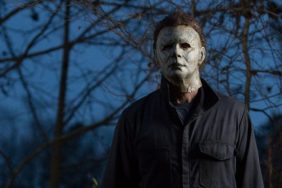
There was a moment during A Good Marriage, adapted by Stephen King from his own novella and directed by Peter Askin (Company Man), where I thought to myself, you know, I’m kind of digging this. In the aforementioned scene, gas station lights and a restaurant sign in the background provide a cool ambience as an unidentified woman walks out to her car, the screen fading in from black to reveal a noirish gray color palette. A dull, eerie piano score kicks in as the woman gets into her car and drives away, unknowingly tailed by another vehicle from which the action is captured.
Unfortunately this is the opening shot of the film, and it is followed shortly by a clichéd opening monologue, a generic party sequence, an uncomfortable sex scene, and some seriously hokey dialogue. I’m not sure either King or Askin had terribly lofty ambitions for the film anyway, as it is quite a frivolous affair, but after all that it was hard to take A Good Marriage very seriously, much to the movie’s detriment.
Anthony LaPaglia (“Without a Trace“) and Joan Allen (The Bourne Legacy) star as Bob and Darcy, members of the titular marriage who seem to have it all. Bob is the top accountant at his firm, considered one of the “good guys” who lives his life by the numbers, while Darcy is an empty-nester who spends her days at home operating the couple’s small coin collecting and trading business. The pair live in a traditionally quiet, nondescript New England town turned upside down by a serial killer named “Beadie“, who has just offed his dozenth female victim.
Reminiscent of the real-life BTK Killer, Beadie tortures his victims before killing them, and later sends their identification cards to the police along with a note claiming responsibility for the crime. When Bob is out of town, Darcy discovers a trove of evidence linking her morally astute husband to Beadie’s most recent killing, namely a handcrafted box hidden in the garage with the victim’s library card and driver’s license inside. Now privy to her husband’s most sinister secret, Darcy begins to fear for her own life and experiences sharp psychological side effects.
If those last couple nuggets feel like spoilers, I promise you they aren’t. The trailer and other marketing materials make it clear as day Bob is the man responsible for the crimes. What’s more, the story isn’t about catching the killer and solving a mystery, but rather how a murderer’s wife could go so long without knowing the truth and how this new knowledge affects her psychological health and the way she chooses to live her life. It’s a pretty interesting premise on its face, especially considering the parallels to the BTK Killer, but unfortunately the movie loses steam very early on and fails to regain traction, instead sputtering at every turn until it finally stalls out with a “shocking” little twist near the end that I’m sure most could see coming from a mile away. Further, the film ends with a set of needlessly melodramatic events that push it even further over the top and made me question the moral integrity and cognitive ability of its central female character.
Among the cast, no one is especially strong, though Kristen Connolly (The Cabin in the Woods) as Bob and Darcy’s soon-to-be-wed daughter Petra brings some charm and emotional depth to several key scenes that make her character far more believable than most of the others. Everyone else, namely LaPaglia, Allen, and Stephen Lang, as a retired detective, are serviceable at best, though none of those three are above hamming it up and thus lending a bit unintended comic relief to the affair.
A Good Marriage by no means shoots for the stars, it is a rather straightforward attempt at a psychological thriller, but the film would have benefit from at least a little narrative or thematic ambition. There just isn’t enough engaging content here to fill a full feature film. The chief concept is an interesting one — What would you do if you found out your spouse was a serial killer? — but Joan Allen’s character makes up her mind pretty quickly on the matter and the rest of the film sees her carrying on with her life with only scant personal and psychological consequences, which immediately makes the film less interesting, and less tense as a result.
The most disagreeable part of the film for me, however, wasn’t the unnecessary melodrama, the lacking performances, or even the fact there is so little tension to be found in what has been billed as a “psychological thriller.” No, the worst offense here is the fact King’s script, his first since Pet Sematary twenty-five years ago, relies on undercooked genre techniques like dream sequences in order to build tension by making the audience unsure of what’s going on. While this is undoubtedly done to place us inside Darcy’s mind and help us understand her newfound paranoia, these dream sequences are painfully obvious, and as such they ruin any already established tension while simultaneously undermining the intellectual capacity of the audience, which is a big no-no for films in general, and thrillers especially.
There is the shell of a good movie visible in A Good Marriage — a meager skeleton but a shell no less — but King’s script lacks narrative and thematic depth as well as trust in the audience, which leaves Askin with a difficult task as director. Further, it treads back across paths it has already traveled, which makes the 103-minute film feel far longer than it is. It’s reminiscent of all those Lifetime mysteries your grandmother and aunt made you watch as a kid (at least I hope that wasn’t just me), a soapy thriller with too many suds to wade through and not enough thrills to enjoy or themes to chew on.









